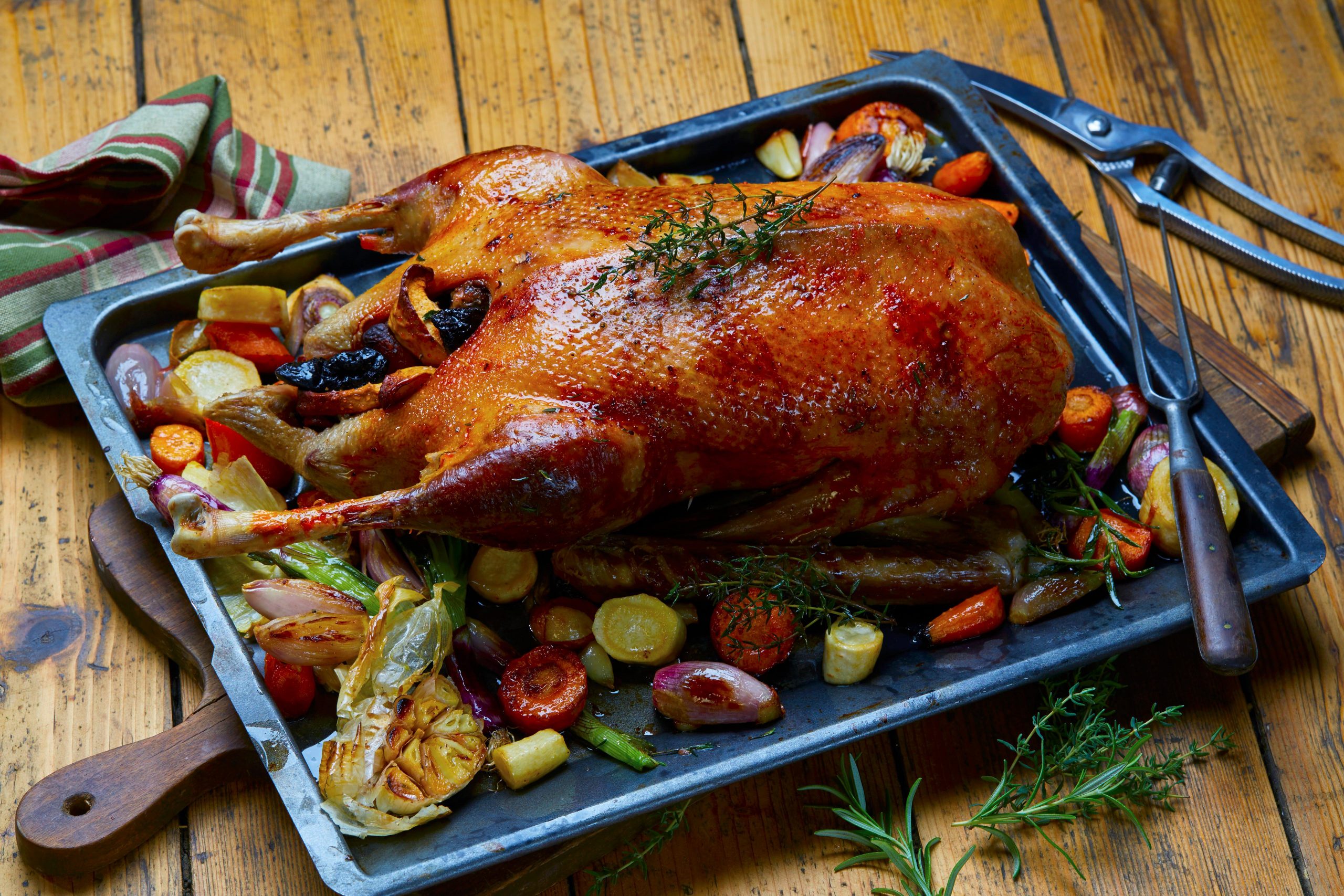How to cook a goose if you're having one for Christmas, by Tom Parker Bowles
They may be notoriously vicious and loud, but, once cooked, geese promise succulent dark meat and delectably tasty fat, especially at Christmas, says Tom Parker Bowles.


‘The goose,’ mused doctor and scholar Julius Caesar Scaliger, ‘is the most beautiful emblem of prudence.’ He goes on to describe how the birds not only lower their heads when passing under bridges, ‘no matter how high the arches are’, but put a pebble in their beak when crossing a mountain known for its marauding eagles. ‘Because knowing what chatterboxes they are, they ensure they will not emit the sounds which would cause their enemies to discover them.’
Better still, Alexandre Dumas recalls being told of a goose that turned a spit upon which a turkey was roasting. By sticking out and pulling back her neck, the motion mimicked a human arm. ‘All she needed,’ he wrote admiringly, ‘was to be given a drink from time to time.’ Then, of course, there’s the tale of one particularly vigilant goose in ancient Rome, who heard the noise made by the Gauls attempting to secretly storm the Capitoline and awoke all her friends. The resultant din roused that great soldier Manlius and disaster was averted.
Not that this noble duty saved them from the pot. The Romans devoured them with much enthusiasm and, like the Egyptians, gorged the birds to enlarge their liver — an early form of foie gras. Back in Britain, every farmyard had a flock of them, strutting, honking, hissing and making the most awful, stinking mess. Clean, they ain’t. As children, my sister and I were terrified by the brutes, traumatised by being chased from some hidden nest by a violently broody mother. When they’re alive, I still give them a respectfully wide berth.
Once safely slaughtered, however, it’s a whole different matter and my fear turns to abject adoration. Because geese make the most magnificent eating. Well before that bland arriviste, the turkey, gobble-gobbled onto the scene, goose was our traditional Christmas bird, lustily pagan, rather than blandly pious, a throwback to the festive bacchanalia of old. Not only does the flesh have the most richly intense flavour, but you get all that luscious fat, too. Wonderful for roasting potatoes, but also, a couple of centuries back, a miracle elixir, used for everything from hand moisturiser and poultice to leather balm and hoof polisher.
Michaelmas, on September 29, was once one of many fast days. But, thanks to the goose being classified as ‘waterfowl’, rather than meat, it could be eaten with greedy glee, tasting all the better from having been fattened on corn left behind after harvest.
And while it’s only possible to get geese around Christmas (my favourites come from Seldom Seen in Leicestershire and Goodman’s in Worcestershire), the traditional cooking of south-western France is still lubricated by goose fat, with the Germans and eastern Europeans also avid fans. Look out for the roast goose of Shantou, in southern China, which is rightly revered. One caveat, however. This is a bird that exits the oven rather smaller than it went in, thanks to losing all that fat. Leftovers are a rare treat.
How to cook roast stuffed goose with prunes in Armagnac
This recipe comes from Delia Smith’s Christmas. As ever with her recipes, they are utterly foolproof. She is a culinary saint.
Sign up for the Country Life Newsletter
Exquisite houses, the beauty of Nature, and how to get the most from your life, straight to your inbox.
Ingredients
Serves 8
- 1 goose with giblets, weighing 10lb–12lb (4.5–5.4kg). Reserve the liver
For the goose giblet stock
- 2fl oz (55ml) wine for the gravy
For the apple stuffing
- 1½lb (700g) Bramley apples, peeled, cored and cut roughly into ½in (1cm) slices
- 8oz (225g) prunes
- 1 large onion, roughly chopped
- 2tspn Armagnac
- 1/8 level tspn ground cloves
- ¼ level tspn ground mace
- Salt and fresh black pepper
For the forcemeat stuffing
- 1 Cox’s apple, peeled, cored and finely chopped
- 10oz (275g) good-quality sausagemeat
- 1 medium onion, finely chopped
- 2oz (50g) fresh breadcrumbs
- 2 level tspn dried sage
- Salt and fresh black pepper
For the prunes in Armagnac
- 12oz (350g) ready-to-eat prunes
- 5fl oz (150ml) Armagnac
- 1 pint (570ml) cold tea
- 2oz (50g) granulated sugar
Method
Soak the prunes overnight in the cold tea, drain, barely cover with water, add the sugar and simmer for 15 minutes. Drain, sprinkle over the Armagnac, cover and leave in the fridge.
Make the apple stuffing by mixing all the ingredients together.
Make the forcemeat stuffing by mixing all the ingredients together with the reserved goose liver, finely chopped.
Place the forcemeat stuffing into the neck-flap end of the goose, pressing it in as far as you can. Secure the flap underneath with a small skewer.
Place the apple stuffing in the body cavity. Season the goose well and lay it on a rack in a roasting tin, then place it in the centre of the pre-heated oven. Give it 30 minutes’ initial cooking at 220˚C (gas mark 7), then reduce the temperature to 180˚C (gas mark 4) and give it another three hours.
Meanwhile, make the stock with the giblets (bring to boil in two pints of water with a carrot, onion, celery stick, bay leaf and peppercorns. Simmer for two hours and strain).
Remove the bird to a serving dish and allow it to rest for 20 minutes. Drain off the fat from the tin (reserve for roast potatoes) and make a light gravy with the giblet stock and a little wine. Heat the prunes gently in a frying pan and serve separately.
Tom Parker Bowles is food writer, critic and regular contributor to Country Life.

